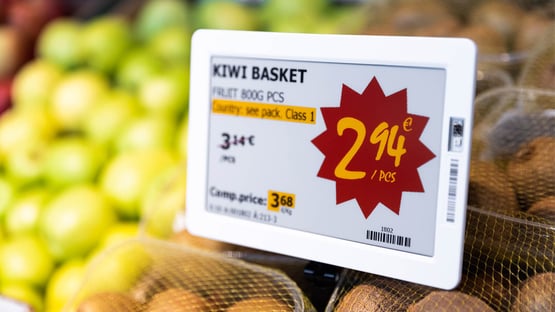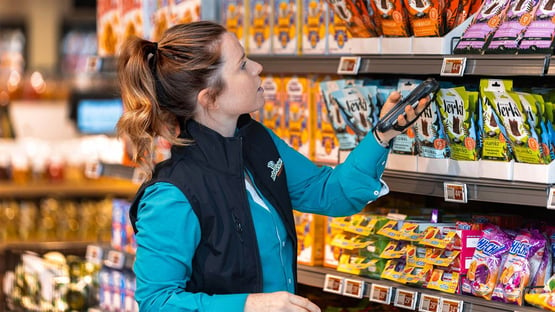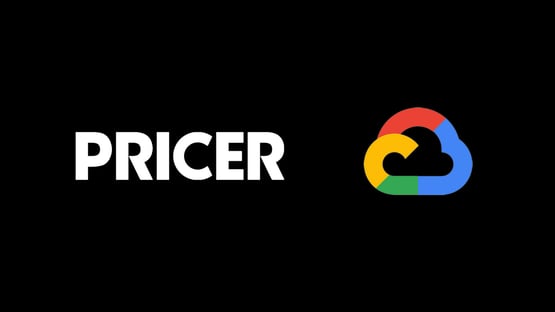The days of the paper label in retail are numbered as new uses are found that serve both retailers and their customers.
Adoption of in-store automation and communication solutions with Electronic Shelf Labels (ESLs) in supermarkets has over many years been inconsistent from country to country, even allowing for differences in the reasons given for their deployment. However, it now looks as though a number of trends have converged to provide a solid business case that will convince more retailers to call time on traditional paper labels.
The trends all come from different areas, mainly cost savings and operational efficiencies, advances in technology, increased competition, and a desire to cut waste, which force retailers to think about both customer service and operational costs.
In many countries, one of the spurs so far appears to have been waste, based on both customers’ expectations that their favourite grocers will act sustainably to do something about reducing food waste, and legislation that now requires it. A number of the large grocers are now trialling electronic shelf labels in order to reduce waste currently managed using paper markdown stickers, manually applied to expiring goods.
Using ESLs for every product on the shelves, prices and discounts can be displayed dynamically, meaning they can be changed instantly and universally, doing away with stickers altogether. Using digital dynamic pricing solutions for products that are near their use or sell-by date, prices can be reduced to reflect this, making the customer an instant offer.
Estimates vary when talking to retail analysts, but on average, food waste could be cut by as much as 30% and significant margin recovered through markdown rather than disposal. This neatly reflects a change in attitudes towards wonky vegetables and food that is perfectly serviceable days - even weeks - after the official sell by date ends. The stigma once attached to these new shopping habits has now almost disappeared, thanks in part to the continuing cost-of-living crisis brought on by inflation.

While the decision to deploy may be solely about markdowns, the business case on labour savings alone is compelling. The value of ESLs is principally to do with time saved not having to print and replace price tags. Pricer’s own research with a major food retail chain, based on 500 price changes per week and two minutes to change each price tag (including printing, sorting and finding the right product) at an hourly cost of €15, totals more than EUR 17,000 a year in savings.
The benefits do not stop there. Because prices can be changed instantly, in real-time, they are always in step with the competition, whatever strategy they deploy, which is the best way to protect margins. Moreover, universal price management also guarantees price synchronisation across both on- and off-line channels, which meets customer expectations around consistency, and avoids the risk of fines for inconsistency.
ESLs open a whole new world of savings for retailers and benefits for their customers. The early controversies over dynamic pricing or varying the prices of an item according to the time of day have abated.
Price is not the only enabler. As diets fragment in the face of allergies and food preferences based on health or sustainability concerns, and in some cases a fall in trust in manufacturing and processing methods, consumers are looking more deeply into where their food comes from, and how it is produced, shipped and stored. Research commissioned by Pricer among 1,000 consumers in Europe, showed that 57% would like to have more access to product information in addition to pricing at the shelf edge, while a further 57% also said they would like to see sourcing or ingredients information on the shelf.
And they are making decision on this basis already; 45% have been put off buying a complex or considered purchase as there hasn’t been enough product information available in the aisle. And, in terms of how they want to access this information, half (49%) would like more digital signage or information at the shelf edge to help inform their buying decision.
However, it is important to get the balance of information right. 39% said they had become so overwhelmed by being bombarded by information at the shelf edge they had abandoned a purchase altogether.
While governance, customer demand and legislation can feel like a series of calls on budget, the savings from implementing ESLs are significant. Both time and waste can be reduced by automating the checking of item dates.
Paper tries to keep pace with these innovations but it looks like the days of adding more labels on top of yet more labels are starting to pass.



